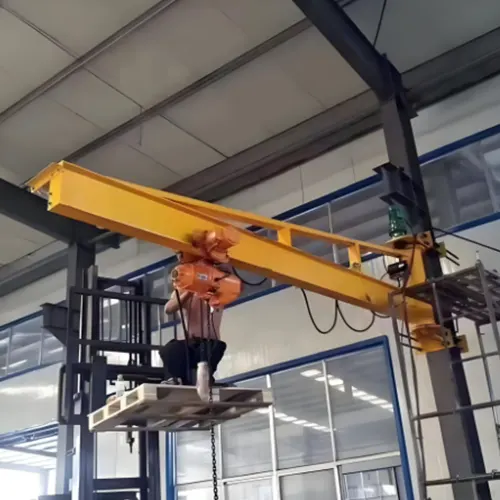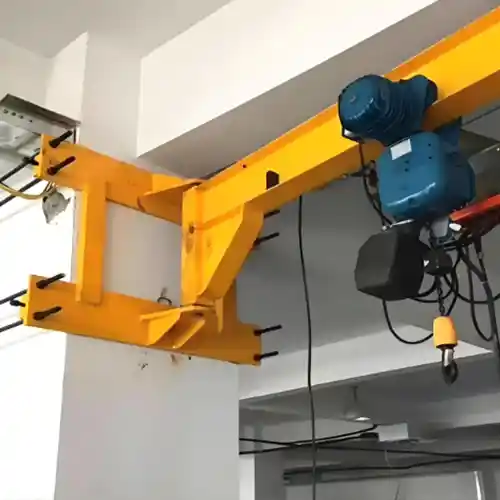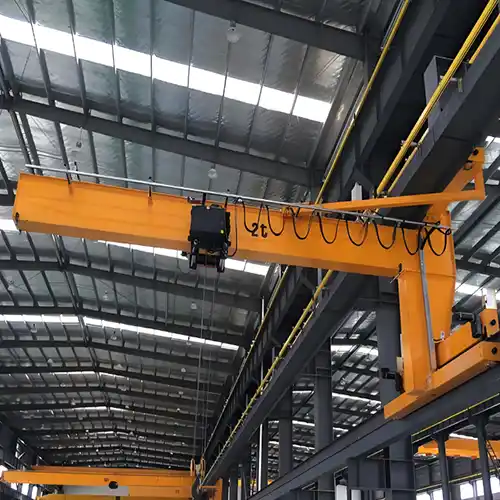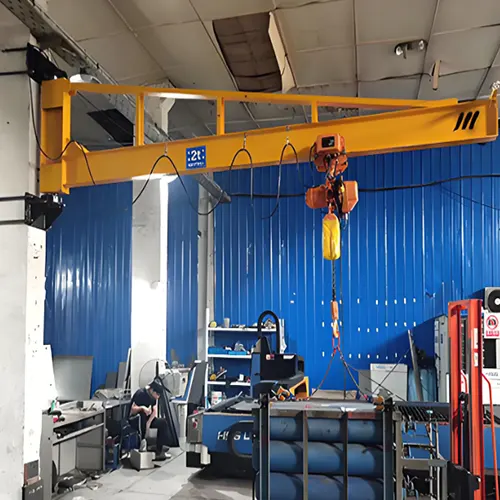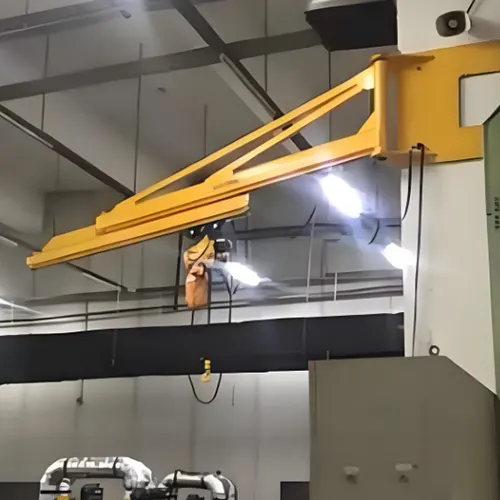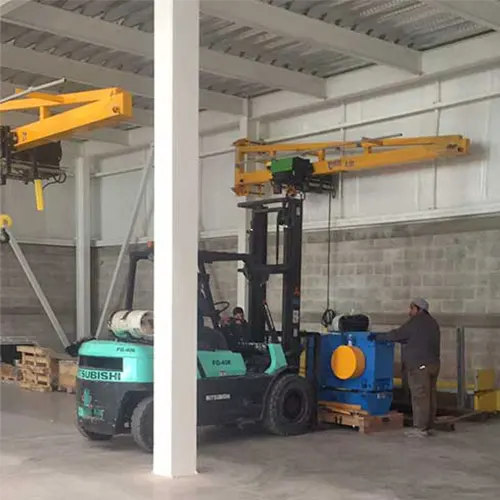1.5 Ton Wall Mounted Jib Crane for Sale Australia, Economical Wall Crane
1.5 ton wall mounted jib crane for sale, tailored wall mounted crane for agricultural use, 4 meter arm, 6 meter lift. Get 1.5 ton jib crane design!
| Wall Crane Type | Wall mounted jib crane |
| Crane span | 4 meters |
| Lifting Height | 6 meters |
| Power supply | 415V, 50Hz, 3-phase electrical supply |
Category: Wall Crane
Your Trusted Wall Jib Crane Manufacturer & Supplier
1.5 Ton Wall Mounted Jib Crane for Sale Australia, Economical Wall Crane
1.5 ton wall mounted jib crane for sale, tailored wall mounted crane for agricultural use, 4 meter arm, 6 meter lift. Get 1.5 ton jib crane design!
1.5 Ton Wall-Mounted Jib Crane for Agricultural Farming in Australia
The objective of this project was to provide and install a 1.5-ton wall-mounted jib crane specifically tailored for agricultural applications in Australia. This crane was selected for its suitability in handling materials efficiently on farms, where reliable and effective equipment is crucial for daily operations.
Crane Type: The chosen crane is a BX Type Wall-Mounted Jib Crane, known for its durability and ease of installation. The BX Type offers a robust design with a tie-rod construction, ensuring stability and long-term performance in various working conditions.
Quantity: The project involved the supply of a single unit of this jib crane. Despite being one unit, it plays a vital role in enhancing the material handling capabilities on the farm, contributing to more streamlined and efficient agricultural operations.
This project features the sale and installation of a 1.5-ton wall-mounted jib crane, designed specifically for agricultural farming applications in Australia. The crane is engineered to enhance material handling capabilities in a farm setting. Key details of the project include:
- Jib Crane Type: BX TypeWall-Mounted Jib Crane for sale
- Capacity: 1.5 tons
- Arm Length: 4 meters
- Lifting Height: 6 meters
- Hoist Type: Electric chain hoist for efficient and reliable lifting
- Crane Power: 415V, 50Hz, 3-phase electrical supply
- Project Application: Agricultural farming, providing effective handling and movement of materials on the farm
- Project Location: Australia
- Quantity: 1 unit
The BX Type tie-rod wall-mounted jib crane offers a durable and stable solution with a 4-meter arm length and a 6-meter lifting height, ideal for various agricultural tasks. The electric chain hoist ensures smooth and precise operation, while the 415V, 50Hz, 3-phase power supply supports reliable performance in farm environments.
Crane Specifications
- Capacity: The jib crane has a lifting capacity of 1.5 tons, allowing it to handle substantial loads commonly encountered in agricultural settings. This capacity ensures the crane can efficiently move and manage a variety of materials and equipment.
- Arm Length: The crane features a 4-meter arm length, providing a wide reach for lifting and transporting items across the farm. This extended reach helps in accessing various areas and improves the crane's versatility in handling different tasks.
- Lifting Height: With a lifting height of 6 meters, the crane can elevate materials to significant heights, facilitating the handling of bulk items and ensuring effective placement in high locations.
- Hoist Type: The crane is equipped with an electric chain hoist, known for its efficiency and reliability. The electric hoist ensures smooth and precise lifting operations, minimizing manual effort and improving overall productivity.
- Crane Power: The crane operates on a 415V, 50Hz, 3-phase electrical supply. This power configuration supports robust performance and consistent operation, suitable for the demanding conditions of a farm environment.
Design and Features
- Jib Crane Type: The crane is a BX Type Wall-Mounted Jib Crane, specifically designed for robust performance in challenging environments. Its wall-mounted design optimizes space and provides a stable and secure solution for material handling.
- Durability: Engineered for exceptional stability, the BX Type crane is built to withstand the rigors of farm environments. Its sturdy construction ensures long-term reliability and minimal maintenance, making it a dependable asset for agricultural operations.
- Arm Length: The crane features a 4-meter arm length, which provides an extensive reach for handling materials across large areas. This extended reach enhances the crane's versatility, allowing it to cover a broader range and improve operational efficiency.
- Lifting Height: With a lifting height of 6 meters, the crane can accommodate various heights for lifting and positioning materials. This capability is essential for managing bulky items and accessing elevated storage or processing areas on the farm.
- Hoist System: Equipped with an electric chain hoist, the crane ensures efficient and reliable lifting operations. The electric hoist offers smooth control and precision, reducing manual effort and increasing productivity in material handling tasks.

Jib arm with the length of 4 m

mounting parts of wall mounted jib crane 1.5 ton

Electric hoist trolley enables the electric chian hoist to travel along the jib crane arm cantilever

Electric chain hoist for material handling
Application and Benefits
Primary Use: The 1.5-ton wall-mounted jib crane is primarily used to enhance material handling capabilities on farms. Its design is tailored to meet the specific needs of agricultural operations, making it a valuable tool for managing various tasks.
Advantages:
- Efficient Handling and Movement: The crane facilitates the smooth and precise movement of materials, improving the efficiency of handling tasks. This efficiency helps in organizing and managing farm operations more effectively.
- Increased Productivity: By streamlining material handling processes, the crane boosts overall productivity on the farm. Its capability to lift and transport items quickly and easily reduces downtime and accelerates work processes.
- Reduced Manual Labor: The electric chain hoist reduces the need for manual lifting and moving of heavy materials. This automation minimizes physical strain on workers and enhances operational efficiency.
- Improved Safety: The crane's design and reliable hoist system contribute to a safer working environment. By minimizing manual handling and providing precise control over lifting operations, the risk of injuries and accidents is significantly reduced.
Project Location and Environment
Location:The 1.5-ton wall-mounted jib crane was installed on a farm in Australia, a country renowned for its extensive and varied agricultural sector. Australia's agricultural landscape includes everything from large-scale crop production to livestock farming, each with its own set of material handling requirements. The choice of crane for this project was influenced by the need to support these diverse agricultural activities effectively.
Environment:
The crane operates in an agricultural farm setting, which presents unique challenges and demands:
- Outdoor Conditions: The crane is exposed to the elements, including dust, dirt, and variable weather conditions. Its design incorporates features to protect against these environmental factors, ensuring long-term durability and performance.
- Temperature Variations: Australian farms often experience wide temperature fluctuations. The crane's components are built to endure these extremes, preventing performance issues and reducing the need for frequent adjustments or maintenance.
- Heavy Usage: Agricultural operations typically involve heavy and frequent material handling. The crane's robust construction and high reliability are essential to manage the continuous demands of lifting and moving substantial loads, such as feed, equipment, and harvested crops.
The crane's design and construction are tailored to meet these specific environmental and operational challenges, ensuring it remains a dependable tool in the demanding farm setting.
Power and Performance
Electrical Supply:
The crane operates on a 415V, 50Hz, 3-phase electrical supply, which is standard for industrial equipment in Australia. This power configuration is crucial for several reasons:
- Stable Operation: The 415V, 50Hz, 3-phase power supply provides a stable and consistent source of electricity, which is essential for the crane's reliable performance. This stability minimizes the risk of electrical issues that could lead to operational disruptions.
- High Power Efficiency: 3-phase power systems are known for their efficiency and ability to handle high loads. This is particularly important in a farm environment where the crane is used frequently and must perform under heavy load conditions without compromising on power.
- Reduced Electrical Overload: The 3-phase supply reduces the risk of electrical overload compared to single-phase systems, ensuring smoother operation and longer equipment life.
Performance:
The crane's performance is finely tuned to meet the demands of agricultural environments:
- Durable Components: The crane is equipped with high-quality, durable components designed to withstand the stresses of regular use and exposure to harsh conditions. This includes heavy-duty bearings, corrosion-resistant materials, and reinforced structural elements to ensure longevity.
- Robust Design: The crane's design incorporates features that enhance its ability to function effectively in challenging conditions, such as protection against dust and moisture. This robust construction helps the crane maintain its performance even in tough farm environments.
- Minimized Downtime: The crane's reliability is a key factor in reducing downtime. Its durable design means fewer breakdowns and less frequent maintenance, which is crucial for maintaining continuous operations on the farm.
- Increased Efficiency: By ensuring that the crane operates efficiently and reliably, the design maximizes the efficiency of material handling tasks. This efficiency translates into smoother farm operations, with quicker handling of materials and less time spent on maintenance and repairs.
Installation and Implementation
Installation Process:
Site Preparation:- Assessment: Conduct a thorough site assessment to determine the optimal location for the crane. Consider factors such as load paths, accessibility, and proximity to material handling areas.
- Foundation: Ensure that the wall where the crane will be mounted is structurally sound and capable of supporting the crane's weight and operational loads. Reinforce the wall if necessary to provide a stable base for installation.
Crane Assembly:
- Component Delivery: Transport the crane components to the installation site. Verify that all parts are present and in good condition before beginning assembly.
- Mounting the Crane: Securely attach the crane's mounting bracket to the wall using heavy-duty bolts and anchors. Ensure the mounting is level and aligned to prevent operational issues.
Electrical Connections:
- Wiring: Connect the crane to the 415V, 50Hz, 3-phase electrical supply. Follow all local electrical codes and safety standards during installation.
- Power Supply: Verify that the power supply is stable and correctly configured to support the crane's operation. Check for any potential electrical issues before powering up the crane.
Safety Measures:
- Protective Gear: Ensure all installation personnel wear appropriate safety gear, including helmets, gloves, and eye protection.
- Safety Checks: Conduct safety checks throughout the installation process to minimize risks and ensure compliance with safety regulations.
Operational Testing:
Initial Power-Up:
- Power Verification: Once installation is complete, power up the crane and check that all electrical connections are functioning correctly.
- System Check: Verify that the crane's control systems and hoist mechanisms are operational.
Functional Testing:
- Load Testing: Perform load tests with a weight that is less than the crane's maximum capacity to ensure it can handle the intended loads safely. Check for any unusual noises or movements during operation.
- Movement Testing: Test all movement functions, including arm rotation, hoist lifting, and lowering. Ensure that the crane operates smoothly and responds accurately to control inputs.
Performance Verification:
- Operational Standards: Confirm that the crane meets all performance standards and requirements, including lifting height, arm reach, and load capacity.
- Safety Features: Test all safety features, such as emergency stops and load indicators, to ensure they are functioning correctly.
Final Adjustments:
- Calibration: Make any necessary adjustments to the crane's settings to optimize performance and ensure that it operates according to the manufacturer's specifications.
- Documentation: Provide the client with operation manuals, maintenance guidelines, and safety information.
Training:
- Operator Training: Train the farm staff on how to operate the crane safely and efficiently. Provide guidance on routine maintenance and troubleshooting procedures.
By following these detailed steps for installation and testing, the crane is set up to perform reliably in its agricultural environment, ensuring smooth and efficient material handling.
Client Feedback and Outcomes
Client Experience:
The client's feedback on the 1.5-ton wall-mounted jib crane highlights significant satisfaction with both the installation process and the crane's performance:
- Ease of Installation: The client appreciated the thorough preparation and professional installation, which minimized disruptions to farm operations. The crane was set up efficiently, with minimal downtime and no issues reported during the installation phase.
- Performance Satisfaction: The client has noted the crane's reliable performance and ease of use. The electric chain hoist provides smooth and precise operation, enhancing the efficiency of material handling tasks.
- Support and Training: The training provided to the farm staff was well-received. The team felt confident operating the crane and appreciated the comprehensive manuals and safety information, which contributed to a smooth transition to using the new equipment.
Impact on Operations:
The installation of the jib crane has had a notable positive impact on the farm's operations:
- Enhanced Material Handling: The crane's ability to handle up to 1.5 tons with a 4-meter arm length and 6-meter lifting height has significantly improved the handling and movement of materials. This enhancement allows for more efficient transport of feed, equipment, and harvested crops, reducing manual labor and the associated risks.
- Increased Productivity: The crane has streamlined various processes on the farm, leading to increased productivity. Tasks that previously required multiple workers or were time-consuming are now completed more quickly and efficiently, enabling the farm to handle a larger volume of work.
- Reduced Manual Labor: By automating material handling, the crane has decreased the need for manual lifting and moving, which has not only reduced physical strain on workers but also minimized the potential for injuries.
- Improved Workflow: The crane's integration into the farm's workflow has optimized operations. With its reliable performance, the farm has seen fewer delays and disruptions, resulting in smoother daily operations and better overall efficiency.
Overall, the 1.5-ton wall-mounted jib crane has proven to be a valuable asset for the agricultural farm, enhancing material handling capabilities, boosting productivity, and contributing to a safer and more efficient working environment.
Conclusion
The installation of the 1.5-ton wall-mounted jib crane has provided substantial benefits to agricultural farming operations in Australia. This crane, with its robust BX Type design, 4-meter arm length, and 6-meter lifting height, has greatly enhanced material handling capabilities on the farm. The efficient electric chain hoist and reliable 415V, 50Hz, 3-phase power supply ensure smooth and dependable performance. By automating material handling, the crane has reduced manual labor, improved safety, and increased overall productivity. The client's positive feedback highlights the crane's role in streamlining farm operations and its value as a dependable asset in the agricultural sector.
If you need any wall mounted jib cranes , please feel free to contact us to get your customized wall mounted jib crane.
Main Projects
Related Products

Supplied three grab bucket crane kits to Indonesia, enhancing garbage handling efficiency with high load capacity and reliable performance.
Free consultation to Confirm Parameters & Specifications and Get
Latest Crane Price & Crane Rate.
- Types of overhead cranes : _______?
- Optional: Overhead travelling crane, goliath gantry crane,Slewing jib crane, Single girder or double girder crane,small portable crane or kbk crane, etc.
- Capacity of overhead crane: _______?
- Optional: 0.25ton, 0.5 ton, 1 ton, 2 ton, 3ton, 5 ton, 10 ton,15ton, 20ton, 25 ton, 30ton,35ton, up to 550ton, etc.
- Crane span & lifting height : _______?
- Crane travelling length : _____?
- Control of overhead crane:_______?
- Optional: pendant/ remote/cabin control
- Voltage supply of overhead crane:_____?
- Eg,: 380V50/60HZ,3Phase or others,etc.
- Application/usage of crane:_______?
- Eg,: Steel mill, ,injection mold, cement,stone, concrete,granite, general manufacturing, etc.
Just leave a message via the contact form and our hoist and crane engineer will contact you with in 24working hours.
Get In Touch
